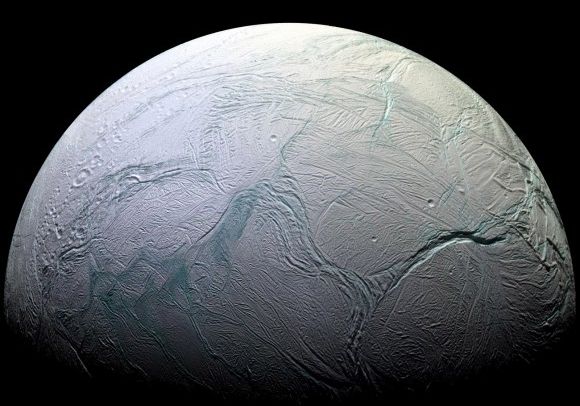Radar evidence shows that geysers on Enceladus are ejecting water that turns to snow. The snow not only falls back on Enceladus' surface, but also makes its way to its neighboring moons, Mimas and Tethys, making them more reflective. Researchers are calling this a 'snow cannon.'
The Cassini spacecraft carried a powerful radar designed to penetrate the thick, opaque, atmosphere of Titan, Saturn's largest moon. But it was also pointed at other moons, including Mimas, Enceladus, and Tethys, in an effort to measure their albedo and characterize their surfaces.
New results from a team of scientists working with Cassini radar data say that some of the data was previously misinterpreted, and that some of Saturn's moons are much brighter than thought. These results, and a model developed to explain them, show that Enceladus is the source of snow that falls on two of Saturn's other moons, increasing their reflectivity.
These radar measurements were intended to measure the albedo of many of Saturn's moons. Enceladus had the highest albedo, and hazy Titan had the lowest. Two of the other moons, Mimas and Tethys had high albedoes, too. In terms of orbits, Mimas and Tethys flank Enceladus. So the three brightest moons were all in proximity to each other.
The results are in a poster being presented at the EPSC-DPS Joint Meeting 2019 in Geneva by Dr. Alice Le Gall. The high albedo of the three moons Enceladus, Mimas, and Tethys point to fresh and clean water ice in the subsurface of the moons, and also to the presence of "scattering structures" that "are especially efficient at returning waves in the backscattering direction" according to the poster.
Dr Le Gall, of LATMOS-UVSQ, Paris, explained: "The super-bright radar signals that we observe require a snow cover that is at least a few tens of centimetres thick. However, the composition alone cannot explain the extremely bright levels recorded. Radar waves can penetrate transparent ice down to few meters and therefore have more opportunities to bounce off buried structures. The sub-surfaces of Saturn's inner moons must contain highly efficient retro-reflectors that preferentially backscatter radar waves towards their source."
But researchers still don't know what these structures are. Enceladus has a variety of surface features and sub-surface features related to impacts and thermal stress on its icy surface. There are pinnacles, ice blocks, and areas of dense cracks. For now there's no evidence that those features can cause the back-scattering.
Icy land-forms can form other more exotic types of structures that could be responsible for the reflectivity. Penitentes are thin, elongated blades of snow or ice that are closely spaced together and point towards the Sun. Suncups are open depressions on a snowy surface that are also highly reflective. But they need a lot of solar energy to form, and it's not clear if they get enough.
Dr. Le Gall and colleagues have developed models that will let them test whether specific features are contributing to the high albedo, or whether more random events are causing it. It's possible that the right fractures on the icy surfaces of these inner moons are causing it.
"So far, we don't have a definitive answer," said Dr Le Gall. "However, understanding these radar measurements better will give us a clearer picture of the evolution of these moons and their interaction with Saturn's unique ring environment. This work could also be useful for future missions to land on the moons."
Saturn's rings and moons are constantly exchanging material. This happens not only with Enceladus, the E-ring, and Mimas and Tethys. It also happens with the Phoebe ring, which coats the leading edge of the moon Iapetus with dark material, reducing its brightness.
The rings are a source of both visual and scientific fascination, with new research sometimes showing that the rings are very old, and sometimes showing that they're very young. Though the Cassini mission answered a lot of questions about the Saturn system, research like this shows that there are still a lot of mysteries yet to be solved.
More:
- Press Release: ‘Snow-cannon’ Enceladus shines up Saturn’s super-reflector moons
- Research Poster: Saturn’s inner moons: why are they so radar-bright?
 Universe Today
Universe Today





